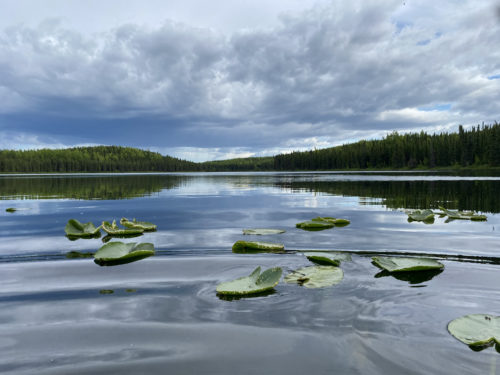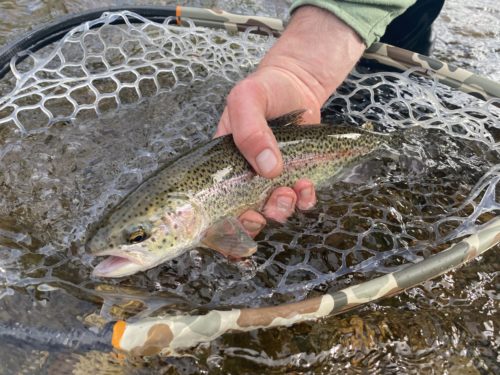A Trek For Trout: Angler’s Quest For Alaska ‘Bows, Cutts, Grayling, Etc.

The following appears in the August issue of Alaska Sporting Journal:
BY DANIEL A. RITZ
Earlier this year, I came to Alaska with the sincere goal of returning home to Idaho with something
remotely close to a comprehensive – or at least a range of – understanding of a true Alaskan experience.
Considering the expanse of the state’s geography and the historically complex nature of the fishing culture, I knew that was a tall order. Bottoms up.
I WAS PLANNING TO spend nearly one month in Alaska – Memorial Day until near the end of June – as one of the first legs of a nearly five-month trip across the American West’s 12 states.
Overall, I was in pursuit of the 20 native trout and char species recognized by the Western Native Trout Initiative’s Western Native Trout Challenge (westernnativetrout.org).
While one month doesn’t seem like all that long, it was admittedly more time than I needed simply for fishing. I wanted to travel by foot. I wanted to camp out of doors or with new friends. I wanted to be engaged with Alaska and not just check the bucket list box as easily and efficiently as possible.
As I traveled from the southeast to Fairbanks and then through Southcentral Alaska to the Kenai Peninsula in an attempt to form very literal connections with each of the six native trout and char species of Alaska – coastal cutthroat trout, Dolly Varden, Arctic grayling, Alaskan lake trout, Alaskan rainbow trout and Arctic char – I began to notice something. More specifically, I began to notice the lack of something when talking to folks about my current project.
Photo by Oliver Ancans
DURING MY TIME IN Alaska, when someone referred to “trout fishing,” they focused
almost exclusively on the large Alaskan rainbow trout near Bristol Bay, or the fish that seasonally follow salmon through popular fisheries such as the Kenai or Susitna River systems in order to feast on their eggs. There were a variety of seasoned anglers that I obviously caught off-guard when I told them that I was actually seeking out, for example, Arctic grayling or coastal cutthroat trout.
“There are six native species of trout in Alaska?” was a common response.
In early May, while researching and preparing for my upcoming trip, I spoke by phone with Eric Booton, sportsmen engagement organizer for Trout Unlimited Alaska. When I asked him about the prominence of the various native trout and char species within the focus of the Alaska sportfishing community, I was taken back by his simple yet profound answer.
“A lot of people in Alaska are fishing for trout, sure, but salmon are far and away the prominent and most engaged sportfishing species,” Booton told me.
That part wasn’t necessarily surprising. Many would confirm and I would personally agree with that assessment – deservedly so. The way of the salmon is the way of the trout. It was the beautifully simple reason why I wasn’t able to get it off my mind.
“In Alaska, unlike the Lower 48 where there is all this attention on native species – namely trout – I don’t think native trout species get as much attention because they aren’t necessarily in trouble. I have a feeling that we aren’t focused on them as much as we could be because we don’t really have to be,” Booton stated.
With a laugh, he said he regularly gets asked why his group isn’t called “Salmon Unlimited Alaska.”
A 2015 Trout Unlimited report notes that three of the United States’ – including the Lower 48 and Alaska – 28 native trout species and subspecies have already gone extinct. Furthermore, 13 of the 25 remaining species inhabit a quarter of their original range.
Thankfully, none of those extinct species or native trout now surviving within radically reduced habitat are Alaskan native fish.

ROUGHLY HALFWAY THROUGH MY time in Alaska, I actually met up with Booton in order to pursue, of all things, Alaskan rainbow trout. To my surprise, throughout our marathon 14-hour fishing day, it was fulfilling to learn the tactics of effective mousing from the Energizer bunny-like Booton. There were tales of fly fishing for Alaskan lake trout in a snowstorm during ice-off on a lake deep in the Alaska Range. I filled him in on my plans to pursue elusive and genetically pure Arctic char in
the Swanson River and Swan Lake canoe routes of the Kenai National Wildlife Refuge.
“I really want to get down/up/over here and do that,” Booton would say. When he did, each time I would find myself feeling grateful for this crash course in Alaskan context. Seeing him so excited for what was, even to him, a novel experience was incredibly invigorating.

Photos by Gaby Mordini and Daniel A. Ritz


EACH OF THESE TROUT species took me to new landscapes, literally forced me to engage with new communities and often learn a totally new cache of fishing tactics. Most of all, my experiences pursuing these six species provided a bit of historical and biologically cohesive narrative to the complex systems of Alaskan fisheries.
In order to know a thing, as they say, you have to walk a mile in its shoes. Well, fish don’t wear shoes, but I covered many miles in Alaska’s rivers.
Whether Alaska is the true Last Frontier or not can be debated, but it certainly was the closest damn thing this hatch-matching, dry-fly ballerina and Rocky Mountain mainlander has seen to a healthy fisheries ecosystem.
I suppose it boils down to, maybe the next time someone tells you they’re “goin’ trout fishin,’” ask them what kind? It might just lead to a good story about an often forgotten species that, like a well- behaved child, doesn’t get the attention it deserves because it isn’t a problem. ASJ
Editor’s note: You can read all of Daniel Ritz’s #WesternTroutChallenge stories on Trout Unlimited’s magazine website. Go to tu.org/magazine/author/daniel-ritz/ for more. As of press time, Ritz has successfully caught 14 of the available 18 native trout species of the American West.



